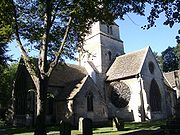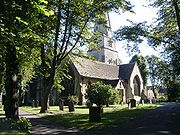
St Mary's Church, Cheltenham
Encyclopedia
St Mary's Church, Cheltenham (Grid reference
: ) is a parish church in the Church of England
in Cheltenham
.
. It has been in continuous use for 850 years, though between 1859 and 1877 it was closed intermittently for repairs.
It is believed to have replaced a Saxon church erected on this site in the 8th century. In the Domesday Book the church and its land were recorded as belonging to William I's chancellor, Reinbald, who then bequeathed it to Cirencester Abbey
. After the Dissolution of the Monasteries by Henry VIII it became crown property and remained so until the mid-nineteenth century.
 Parts of the church represent the Early English style of architecture, but thanks to later extensions it is the decorated style which predominates. The baptistry (formerly the north porch) is early perpendicular and boasts a good example of lierne vaulting. The tracery of the windows is reflects architectural developments between 1250 and 1350. The stained glass of the windows is late Victorian and regarded as of particularly high quality. The woodwork is Victorian or later, and the south porch is a late Victorian addition.
Parts of the church represent the Early English style of architecture, but thanks to later extensions it is the decorated style which predominates. The baptistry (formerly the north porch) is early perpendicular and boasts a good example of lierne vaulting. The tracery of the windows is reflects architectural developments between 1250 and 1350. The stained glass of the windows is late Victorian and regarded as of particularly high quality. The woodwork is Victorian or later, and the south porch is a late Victorian addition.
A notable feature of the church is the spire and bell tower which contains a peal of twelve bells. The upper part of the tower dates from 1200 and the broach spire was added early in the fourteenth century. The tracery of most of the windows is varied and dates from around 1250 to 1350.
The church boasts a number of interesting memorials, including one to Captain Henry Skillicorne, the developer of Cheltenham's first spa. It also commemorates George III's visit to Cheltenham in 1788 when he attended a number of services in St Mary's. There is also a touching memorial to a former priest, John English, who was imprisoned by the Puritans.
Its most famous incumbent was Francis Close, a keen Evangelical, who was a follower of Revd Charles Simeon. Close was the perpetual curate of the church for thirty years and a founder of two teacher training colleges which later became the University of Gloucestershire
. He moved on to become Dean of Carlisle in 1856.
 For most of its history St Mary's Church served a population of less than 1,500 and was a prominent feature of the landscape. But extensive building occurred during the Regency period (early 19th century) and as a result the church is now hidden behind shops and offices. In Victorian times a number of new churches were built to cope with Cheltenham's rapidly expanding population.
For most of its history St Mary's Church served a population of less than 1,500 and was a prominent feature of the landscape. But extensive building occurred during the Regency period (early 19th century) and as a result the church is now hidden behind shops and offices. In Victorian times a number of new churches were built to cope with Cheltenham's rapidly expanding population.
In 1863 the Revd Edward Walker proposed the enlargement or replacement of St Mary's. Thirty-four plans were submitted, but because of opposition the proposal was abandoned and instead between 1875 and 1877 the church was restored
and equipped with gas lighting and a new heating system.
The temporary building in Clarence Street was eventually replaced by a permanent stone building which was consecrated in 1879 as St Matthew's. The then rector, Revd Charles Bell, applied to make St Matthew's the parish church, but the proposal was rejected by the parishioners. Today the two churches form the parish of 'St Mary with St Matthew'.
A group, known as the The Friends of St Mary's, Cheltenham raises funds for the upkeep of the church and has an informative website.
British national grid reference system
The Ordnance Survey National Grid reference system is a system of geographic grid references used in Great Britain, different from using latitude and longitude....
: ) is a parish church in the Church of England
Church of England
The Church of England is the officially established Christian church in England and the Mother Church of the worldwide Anglican Communion. The church considers itself within the tradition of Western Christianity and dates its formal establishment principally to the mission to England by St...
in Cheltenham
Cheltenham
Cheltenham , also known as Cheltenham Spa, is a large spa town and borough in Gloucestershire, on the edge of the Cotswolds in the South-West region of England. It is the home of the flagship race of British steeplechase horse racing, the Gold Cup, the main event of the Cheltenham Festival held...
.
Background
It is the only surviving medieval building in CheltenhamCheltenham
Cheltenham , also known as Cheltenham Spa, is a large spa town and borough in Gloucestershire, on the edge of the Cotswolds in the South-West region of England. It is the home of the flagship race of British steeplechase horse racing, the Gold Cup, the main event of the Cheltenham Festival held...
. It has been in continuous use for 850 years, though between 1859 and 1877 it was closed intermittently for repairs.
It is believed to have replaced a Saxon church erected on this site in the 8th century. In the Domesday Book the church and its land were recorded as belonging to William I's chancellor, Reinbald, who then bequeathed it to Cirencester Abbey
Cirencester Abbey
Cirencester Abbey in Gloucestershire was founded as an Augustinian monastery in 1117 on the site of an earlier church, the oldest-known Saxon church in England, which had itself been built on the site of a Roman structure. The church was greatly enlarged in the 14th century with addition of an...
. After the Dissolution of the Monasteries by Henry VIII it became crown property and remained so until the mid-nineteenth century.

A notable feature of the church is the spire and bell tower which contains a peal of twelve bells. The upper part of the tower dates from 1200 and the broach spire was added early in the fourteenth century. The tracery of most of the windows is varied and dates from around 1250 to 1350.
The church boasts a number of interesting memorials, including one to Captain Henry Skillicorne, the developer of Cheltenham's first spa. It also commemorates George III's visit to Cheltenham in 1788 when he attended a number of services in St Mary's. There is also a touching memorial to a former priest, John English, who was imprisoned by the Puritans.
Its most famous incumbent was Francis Close, a keen Evangelical, who was a follower of Revd Charles Simeon. Close was the perpetual curate of the church for thirty years and a founder of two teacher training colleges which later became the University of Gloucestershire
University of Gloucestershire
The University of Gloucestershire is a university primarily based in Gloucestershire, England, spread over four campuses, three in Cheltenham and one in Gloucester...
. He moved on to become Dean of Carlisle in 1856.

Two Churches?
St Mary's was condemned as unsafe and closed in July 1859. During the closure the congregation worshipped first in the Town Hall (the predecessor of Cheltenham's current Town Hall) and then in a temporary church built of timber encased with corrugated iron in Clarence Street.In 1863 the Revd Edward Walker proposed the enlargement or replacement of St Mary's. Thirty-four plans were submitted, but because of opposition the proposal was abandoned and instead between 1875 and 1877 the church was restored
Victorian restoration
Victorian restoration is the term commonly used to refer to the widespread and extensive refurbishment and rebuilding of Church of England churches and cathedrals that took place in England and Wales during the 19th-century reign of Queen Victoria...
and equipped with gas lighting and a new heating system.
The temporary building in Clarence Street was eventually replaced by a permanent stone building which was consecrated in 1879 as St Matthew's. The then rector, Revd Charles Bell, applied to make St Matthew's the parish church, but the proposal was rejected by the parishioners. Today the two churches form the parish of 'St Mary with St Matthew'.
A group, known as the The Friends of St Mary's, Cheltenham raises funds for the upkeep of the church and has an informative website.

